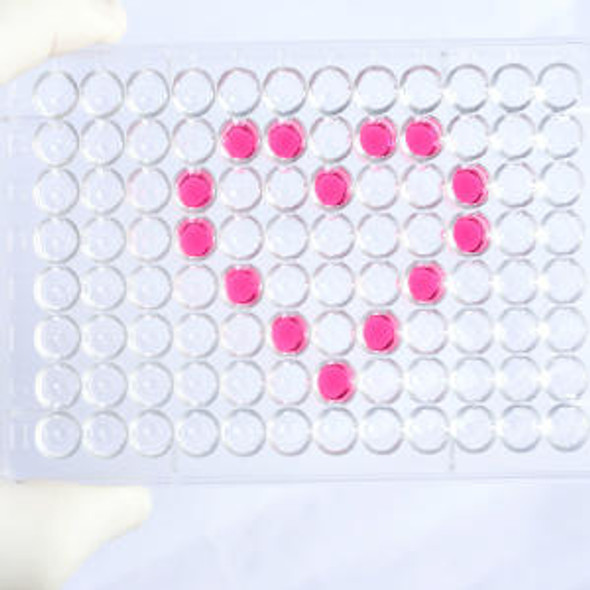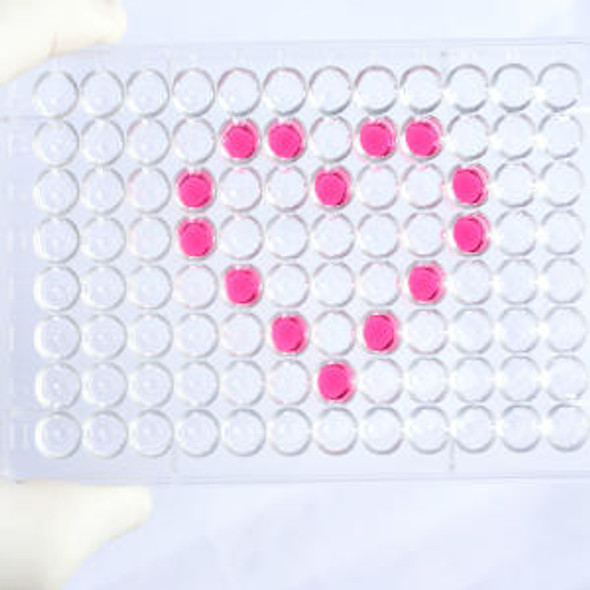Human Immunology ELISA Kits 1
Human LAB7-2/CD86 (B-Lymphocyte Activation Antigen B7-2) CLIA Kit (HUES00924)
- SKU:
- HUES00924
- Product Type:
- ELISA Kit
- ELISA Type:
- CLIA Kit
- Size:
- 96 Assays
- Sensitivity:
- 18.75pg/mL
- Range:
- 31.25-2000pg/mL
- ELISA Type:
- Sandwich
- Reactivity:
- Human
- Sample Type:
- Serum, plasma and other biological fluids
- Research Area:
- Immunology
Description
| Assay type: | Sandwich |
| Format: | 96T |
| Assay time: | 4.5h |
| Reactivity: | Human |
| Detection method: | Chemiluminescence |
| Detection range: | 31.25-2000 pg/mL |
| Sensitivity: | 18.75 pg/mL |
| Sample volume: | 100µL |
| Sample type: | Serum, plasma and other biological fluids |
| Repeatability: | CV < 15% |
| Specificity: | This kit recognizes Human LAB7-2/CD86 in samples. No significant cross-reactivity or interference between Human LAB7-2/CD86 and analogues was observed. |
This kit uses Sandwich-CLIA as the method. The micro CLIA plate provided in this kit has been pre-coated with an antibody specific to Human LAB7-2/CD86. Standards or samples are added to the appropriate micro CLIA plate wells and combined with the specific antibody. Then a biotinylated detection antibody specific for Human LAB7-2/CD86 and Avidin-Horseradish Peroxidase (HRP) conjugate are added to each micro plate well successively and incubated. Free components are washed away. The substrate solution is added to each well. Only those wells that contain Human LAB7-2/CD86, biotinylated detection antibody and Avidin-HRP conjugate will appear fluorescence. The Relative light unit (RLU) value is measured spectrophotometrically by the Chemiluminescence immunoassay analyzer. The RLU value is positively associated with the concentration of Human LAB7-2/CD86. The concentration of Human LAB7-2/CD86 in the samples can be calculated by comparing the RLU of the samples to the standard curve.
| UniProt Protein Function: | CD86: Receptor involved in the costimulatory signal essential for T-lymphocyte proliferation and interleukin-2 production, by binding CD28 or CTLA-4. May play a critical role in the early events of T-cell activation and costimulation of naive T-cells, such as deciding between immunity and anergy that is made by T- cells within 24 hours after activation. Isoform 2 interferes with the formation of CD86 clusters, and thus acts as a negative regulator of T-cell activation. 4 isoforms of the human protein are produced by alternative splicing. |
| UniProt Protein Details: | Protein type:Immunoglobulin superfamily; Membrane protein, integral Chromosomal Location of Human Ortholog: 3q21 Cellular Component: cell surface; intracellular membrane-bound organelle; plasma membrane; integral to membrane; external side of plasma membrane Molecular Function:protein binding; coreceptor activity; receptor activity; receptor binding Biological Process: positive regulation of lymphotoxin A biosynthetic process; negative regulation of T cell anergy; T cell activation; viral reproduction; nerve growth factor receptor signaling pathway; positive regulation of transcription, DNA-dependent; positive regulation of interleukin-2 biosynthetic process; myeloid dendritic cell differentiation; positive regulation of activated T cell proliferation; positive regulation of interleukin-4 biosynthetic process; positive regulation of T-helper 2 cell differentiation; cell-cell signaling; T cell proliferation during immune response; positive regulation of cell proliferation; response to yeast; defense response to virus; aging; response to drug; epidermal growth factor receptor signaling pathway; fibroblast growth factor receptor signaling pathway; phosphoinositide-mediated signaling; B cell activation; T cell costimulation; toll-like receptor signaling pathway; innate immune response; immune response |
| NCBI Summary: | This gene encodes a type I membrane protein that is a member of the immunoglobulin superfamily. This protein is expressed by antigen-presenting cells, and it is the ligand for two proteins at the cell surface of T cells, CD28 antigen and cytotoxic T-lymphocyte-associated protein 4. Binding of this protein with CD28 antigen is a costimulatory signal for activation of the T-cell. Binding of this protein with cytotoxic T-lymphocyte-associated protein 4 negatively regulates T-cell activation and diminishes the immune response. Alternative splicing results in several transcript variants encoding different isoforms. [provided by RefSeq, May 2011] |
| UniProt Code: | P42081 |
| NCBI GenInfo Identifier: | 317373339 |
| NCBI Gene ID: | 942 |
| NCBI Accession: | P42081. 2 |
| UniProt Secondary Accession: | P42081,Q13655, Q6FHB1, Q6GTS4, Q7M4L5, A0N0P0, B7Z2F3 B7Z702, E7ETN5, E9PC27, |
| UniProt Related Accession: | P42081 |
| Molecular Weight: | 329 |
| NCBI Full Name: | T-lymphocyte activation antigen CD86 |
| NCBI Synonym Full Names: | CD86 molecule |
| NCBI Official Symbol: | CD86 |
| NCBI Official Synonym Symbols: | B70; B7-2; B7. 2; LAB72; CD28LG2 |
| NCBI Protein Information: | T-lymphocyte activation antigen CD86; BU63; FUN-1; CTLA-4 counter-receptor B7. 2; B-lymphocyte activation antigen B7-2; CD86 antigen (CD28 antigen ligand 2, B7-2 antigen) |
| UniProt Protein Name: | T-lymphocyte activation antigen CD86 |
| UniProt Synonym Protein Names: | Activation B7-2 antigen; B70; BU63; CTLA-4 counter-receptor B7. 2; FUN-1; CD_antigen: CD86 |
| UniProt Gene Name: | CD86 |
| UniProt Entry Name: | CD86_HUMAN |
As the RLU values of the standard curve may vary according to the conditions of the actual assay performance (e. g. operator, pipetting technique, washing technique or temperature effects), the operator should establish a standard curve for each test. Typical standard curve and data is provided below for reference only.
| Concentration (pg/mL) | RLU | Average | Corrected |
| 2000 | 51004 60438 | 55721 | 55693 |
| 1000 | 23381 24567 | 23974 | 23946 |
| 500 | 11524 10540 | 11032 | 11004 |
| 250 | 4957 5631 | 5294 | 5266 |
| 125 | 2704 2512 | 2608 | 2580 |
| 62.5 | 1400 1222 | 1311 | 1283 |
| 31.25 | 635 713 | 674 | 646 |
| 0 | 27 29 | 28 | -- |
Precision
Intra-assay Precision (Precision within an assay): 3 samples with low, mid range and high level Human LAB7-2/CD86 were tested 20 times on one plate, respectively.
Inter-assay Precision (Precision between assays): 3 samples with low, mid range and high level Human LAB7-2/CD86 were tested on 3 different plates, 20 replicates in each plate.
| Intra-assay Precision | Inter-assay Precision | |||||
| Sample | 1 | 2 | 3 | 1 | 2 | 3 |
| n | 20 | 20 | 20 | 20 | 20 | 20 |
| Mean (pg/mL) | 91.20 | 193.36 | 818.30 | 88.14 | 185.49 | 859.15 |
| Standard deviation | 11.05 | 15.43 | 59.00 | 7.21 | 14.65 | 61.26 |
| C V (%) | 12.12 | 7.98 | 7.21 | 8.18 | 7.90 | 7.13 |
Recovery
The recovery of Human LAB7-2/CD86 spiked at three different levels in samples throughout the range of the assay was evaluated in various matrices.
| Sample Type | Range (%) | Average Recovery (%) |
| Serum (n=5) | 91-104 | 98 |
| EDTA plasma (n=5) | 98-111 | 105 |
| Cell culture media (n=5) | 99-117 | 107 |
Linearity
Samples were spiked with high concentrations of Human LAB7-2/CD86 and diluted with Reference Standard & Sample Diluent to produce samples with values within the range of the assay.
| Serum (n=5) | EDTA plasma (n=5) | Cell culture media (n=5) | ||
| 1:2 | Range (%) | 92-107 | 85-99 | 86-96 |
| Average (%) | 98 | 92 | 91 | |
| 1:4 | Range (%) | 95-106 | 92-106 | 99-115 |
| Average (%) | 100 | 98 | 106 | |
| 1:8 | Range (%) | 92-103 | 85-97 | 96-111 |
| Average (%) | 97 | 92 | 101 | |
| 1:16 | Range (%) | 85-99 | 101-119 | 101-115 |
| Average (%) | 92 | 109 | 107 |
An unopened kit can be stored at 4°C for 1 month. If the kit is not used within 1 month, store the items separately according to the following conditions once the kit is received.
| Item | Specifications | Storage |
| Micro CLIA Plate(Dismountable) | 8 wells ×12 strips | -20°C, 6 months |
| Reference Standard | 2 vials | |
| Concentrated Biotinylated Detection Ab (100×) | 1 vial, 120 µL | |
| Concentrated HRP Conjugate (100×) | 1 vial, 120 µL | -20°C(shading light), 6 months |
| Reference Standard & Sample Diluent | 1 vial, 20 mL | 4°C, 6 months |
| Biotinylated Detection Ab Diluent | 1 vial, 14 mL | |
| HRP Conjugate Diluent | 1 vial, 14 mL | |
| Concentrated Wash Buffer (25×) | 1 vial, 30 mL | |
| Substrate Reagent A | 1 vial, 5 mL | 4°C (shading light) |
| Substrate Reagent B | 1 vial, 5 mL | 4°C (shading light) |
| Plate Sealer | 5 pieces | |
| Product Description | 1 copy | |
| Certificate of Analysis | 1 copy |
- Set standard, test sample and control (zero) wells on the pre-coated plate and record theirpositions. It is recommended to measure each standard and sample in duplicate. Note: addall solutions to the bottom of the plate wells while avoiding contact with the well walls. Ensuresolutions do not foam when adding to the wells.
- Aliquot 100 µL of standard solutions into the standard wells.
- Add 100 µL of Sample / Standard dilution buffer into the control (zero) well.
- Add 100 µL of properly diluted sample (serum, plasma, tissue homogenates and otherbiological fluids. ) into test sample wells.
- Cover the plate with the sealer provided in the kit and incubate for 90 min at 37 °C.
- Aspirate the liquid from each well, do not wash. Immediately add 100 µL of BiotinylatedDetection Ab working solution to each well. Cover the plate with a plate seal and gently mix. Incubate for 1 hour at 37 °C.
- Aspirate or decant the solution from the plate and add 350 µL of wash buffer to each welland incubate for 1-2 minutes at room temperature. Aspirate the solution from each well andclap the plate on absorbent filter paper to dry. Repeat this process 3 times. Note: a microplatewasher can be used in this step and other wash steps.
- Add 100 µL of HRP Conjugate working solution to each well. Cover with a plate seal andincubate for 30 min at 37 °C.
- Aspirate or decant the solution from each well. Repeat the wash process for five times asconducted in step 7.
- Add 100 µL of Substrate mixture solution to each well. Cover with a new plate seal andincubate for no more than 5 min at 37 °C. Protect the plate from light.
- Determine the RLU value of each well immediately.






